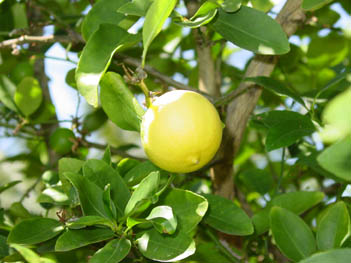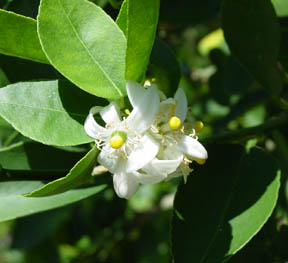



The key lime, or "Citrus Aurantifolia," probably originated in Asia near Burma or Malaysia. Ancient travelers imported key limes to the Middle East and Africa. Even today, Nile farmers sell key limes at bazaars in Egypt. The key lime probably migrated West to Caribbean and Latin America in the 16th century with the help of Portuguese explores and Spanish conquistadors. Now days, key limes are a staple of the Florida Keys where they find safety from the freezing temperatures that plague most of the remaining USA. Commercial key limes for North American grocery stores probably come from Mexico or Central America. Texans call them "Mexican Limes."
Our key lime trees germinated from seeds. Key limes generally "come true to type" from seeds. Unlike other citrus fruit, some say it's best to start a tree from seed because it minimizes transfer of diseases. After I throw a few damaged limes into our garden, seedlings sprout the following season. I plant the seedlings in a pot for the first year or two. This allows easy movement into a warm shed when a cold snap threatens. After transplanting, key lime trees grow vigorously to about 8 feet tall. Trees seem to start flowering within the first 3 years after transplant.
If not for cool weather and short days of winter, our trees would probably bloom all year. At our house in Florida (28N Lat), key lime trees bloom from early spring through early fall. Flowers are quite fragrant and attract a lively menagerie of insects. Fruit is available from early summer until December. During the heart of the season, a mature tree easily produces a gross of limes every week! The fruit starts green, matures to yellow, and then falls to the ground when it's ripe. A typical lime is about the size of a golf ball and holds numerous seeds. Our children collect the limes and sell them to local fruit stands during the summer. Unfortunately, there's little or no profit in the trade.
Key lime trees seem to enjoy the alkaline soil of Florida, although I'm told they aren't very salt tolerant. My trees seem fairly pest tolerant, so it's largely a maintenance free undertaking. Aside from cold sensitivity, key lime trees have one major bad attribute: thorns. Thorns frequently exceed one inch and are down-right nasty sharp. They're a genuine safety hazard!
If you want to learn more about key lime botany, I'd recommend the University of Florida (GO GATORS!) agricultural extension web site, IFAS, or one of the many commercial websites like keylime.com.
Enjoy Key Limes!